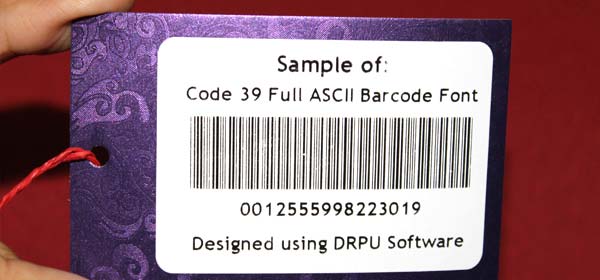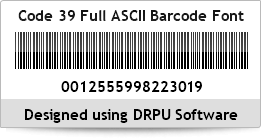Extended Code 39 Barcodes with Standard Fonts. In addition to using the IDAutomationX fonts, lower-case and extended characters may also be encoded with standard Code-39 fonts by adding shift characters according to the Code 3 of 9 Full ASCII Chart. Download Code 128 Barcode Font Free download of code 39 (3 of 9 extended) Barcode Font. This free font package includes two versions. Font named 3 of 9 is the basic standard which includes letters and following symbols ($% + -. The other one is the extended standard which includes the full ASCII character set. Download 3 of 9 Barcode Font. Barcode fonts print at full resolution and can be used with even the most basic office or home printer. Create Code 39 barcodes by placing an asterisk before and after your data, then formatting into Code39Azalea.
Top 4 Download periodically updates software information of code39 full ascii barcode full versions from the publishers, but some information may be slightly out-of-date.
Using warez version, crack, warez passwords, patches, serial numbers, registration codes, key generator, pirate key, keymaker or keygen for code39 full ascii barcode license key is illegal. Download links are directly from our mirrors or publisher's website, code39 full ascii barcode torrent files or shared files from free file sharing and free upload services, including Rapidshare, MegaUpload, YouSendIt, Letitbit, DropSend, MediaMax, HellShare, HotFile, FileServe, LeapFile, MyOtherDrive or MediaFire, are not allowed!
Your computer will be at risk getting infected with spyware, adware, viruses, worms, trojan horses, dialers, etc while you are searching and browsing these illegal sites which distribute a so called keygen, key generator, pirate key, serial number, warez full version or crack for code39 full ascii barcode. These infections might corrupt your computer installation or breach your privacy. code39 full ascii barcode keygen or key generator might contain a trojan horse opening a backdoor on your computer.
Types of Barcodes: Choosing the Right Barcode
There are many types of barcodes—and each brings unique opportunities and challenges to the table. With such a range of options to choose from, it can be tough to determine which barcodes will best suit your products, inventory or assets. Should you invest in 1D or 2D barcodes? Which barcode variants work best for your specific industry? And, most importantly, which barcodes will provide the highest efficiency and business value for your enterprise?
At Scandit, we’re proud to help businesses capitalize on the advantages of barcode scanning. Perhaps your products have less than one square inch of printing space, or maybe you need to print extra-secure codes on corrugated cardboard. No matter what barcode dilemmas your team faces, we can give you the information you need to get started. Today, we’ll be walking through the 13 major 1D and 2D barcode types to help you find the right solution for your processes. We’ll highlight the common uses for each one, as well as their limitations, to help you narrow down your options.
Note: If you need more information related to specific barcode scanning use cases and industry benefits, then check out our free eBook, Choosing the Best Barcode for your Business.
One-Dimensional (1D) Barcode Types
One-dimensional (or 1D) barcodes systematically represent data by varying the widths and spacings of parallel lines. These include some of the most traditional and well-recognized barcode types, such as the UPC and EAN codes.
UPC CODE
UPC barcodes are used to label and scan consumer goods at points of sale around the world—mainly in the United States, but also in the United Kingdom, Australia, New Zealand and other countries. The UPC-A variation encodes twelve numerical digits, while UPC-E is a smaller variation that encodes only six numerical digits.
Industry: Retail
Variations: UPC-A, UPC-E
EAN CODE
EAN barcodes are also used to label consumer goods worldwide for point-of-sale scanning, primarily in Europe. They look very similar to UPC codes, and the main distinction is their geographical application. While EAN-13 (comprising 13 digits) is the default form factor, you’ll find EAN-8 (covering eight digits) barcodes on products where space is very limited, like small candies.
Industry: Retail
Variations: EAN-13, EAN-8, JAN-13, ISBN, ISSN
CODE 39
Code39 barcodes (or Code 3 of 9) are used to label goods across many industries and are often found in the automotive industry and the U.S. Department of Defense. It enables the use of both digits and characters, and its name originates in the fact that it could only encode 39 characters—though in its most recent version the character set has been increased to 43. It’s similar to, but not as compact as, the Code 128 barcode.
Industry: Automotive and Defense
CODE 128
Code 128 barcodes are compact, high-density codes used in logistics and transportation industries for ordering and distribution. They’re geared toward non-POS products, like when supply chain applications label units with serial shipping container codes (SSCC). Because they support any character of the ASCII 128 character set, Code 128 barcodes can store highly diversified information.
Industry: Supply Chain
ITF (Interleaved 2 OF 5)
ITF (or Interleaved 2 of 5) barcodes are used to label packaging materials across the globe. Since they can deal with high printing tolerances, they are ideal for printing on corrugated cardboard. ITF barcodes encode 14 numeric digits and use the full ASCII set.
Industry: Packaging
CODE 93
Code 93 barcodes are used in logistics to identify packages in retail inventory, label electronic components, and even provide supplementary delivery information for the Canadian Post. Like Code 39, Code 93 barcodes come with full ASCII support. Along with enabling additional security within the code itself, the high density and compact size of Code 93s make them around 25% shorter than barcodes produced in Code 39.
Industry: Retail, Manufacturing and Logistics
Learn more about Code 93 barcodes on the Scandit Blog.

CODABAR
Codabar barcodes are used by logistics and healthcare professionals, including U.S. blood banks, FedEx, photo labs and libraries. Their main benefit is that they’re easy to print and can be produced by any impact style printer—even a typewriter. Therefore, users can create many Codabar codes using consecutive numbers without the use of a computer. Codabar is a discrete, self-checking symbology that encodes up to 16 different characters with an additional 4 start/stop characters.
Variations: Codeabar, Ames Code, NW-7, Monarch, Code 2 of 7, Rationalized Codabar, ANSI/AIM BC3-1995, USD-4
Industry: Logistics, Healthcare and Education
Code 39 Full Ascii Font
GS1 DATABAR
GS1 DataBar barcodes (formerly known as Reduced Space Symbology) are used by retail outlets to identify consumer coupons, produce and perishables, as well as small objects in the healthcare industry. They are more compact than typical consumer-facing barcodes. GS1 DataBar was introduced in 2001 and has become the mandated barcode type for retail coupons in the U.S.
Variations: GS1 DataBar Omnidirectional, Truncated, Stacked, Stacked Omnidirectional, Expanded, Expanded Stacked
Industry: Retail and Healthcare
Learn more about GS1 Databar barcodes on the Scandit Blog.
MSI PLESSEY
MSI Plessey (or Modified Plessey) barcodes are used for inventory management in retail environments, such as labeling supermarket shelves.
Industry: Retail
Two-Dimensional (2D) Barcode Types
Two-dimensional, (or 2D) barcodes systematically represent data using two-dimensional symbols and shapes. They are similar to a linear 1D barcode, but can represent more data per unit area. 2D barcodes include some newer barcode types, such as the QR Code and PDF417.
QR CODE
QR codes are most often used in tracking and marketing initiatives, such as advertisements, magazines and business cards. They are flexible in size, offer a high fault tolerance and have fast readability, though they can’t be read with a laser scanner. QR codes support four different modes of data: numeric, alphanumeric, byte/binary, and Kanji. They are public domain and free to use.
Industry: Retail, Entertainment and Advertising
Learn more about QR codes on the Scandit Blog.

DATAMATRIX CODE
Datamatrix codes are usually used to label small items, goods and documents. Their tiny footprint makes them ideal for small products in logistics and operations. In fact, the U.S. Electronic Industries Alliance (EIA) recommends that they be used to label small electronic components. Similar to QR codes, they have high fault tolerance and fast readability.
Variation: Micro-Datamatrix
Industry: Electronics, Retail and Government
Learn more about Datamatrix codes on the Scandit Blog.
PDF417
PDF417 codes are used for applications that require the storage of huge amounts of data, such as photographs, fingerprints and signatures. They can hold over 1.1 kilobytes of machine-readable data, making them much more powerful than other 2D barcodes. Like QR codes, PDF417 barcodes are public domain and free to use.
Variation: Truncated PDF417
Industry: Logistics and Government
AZTEC
Aztec codes are commonly used by the transportation industry, particularly for tickets and airline boarding passes. The barcodes can still be decoded even if they have bad resolution, making them useful when tickets are printed poorly or presented on a phone. They can also take up less space because they don’t require a surrounding blank “quiet zone,” unlike some other 2D barcode types.
Industry: Transportation
Learn more about Aztec codes on the Scandit Blog.
Finding the Best Barcode for Your Business
Now that you have a better understanding of the most common 1D and 2D barcode types and how they’re being used today, here are five questions you can ask yourself to find the right barcodes for your enterprise.
- Will the product be scanned at the point of sale in retail stores? -> UPC, EAN
- Which character set needs to be supported? Alphanumeric characters? -> Code39, Code128, and QR Code.
- How much space is available on the product packaging? -> EAN8, UPC-E, Code128 & Datamatrix have small form factors.
- Which material will you print the barcode on? -> ITF is great for printing barcodes on corrugated cardboard.
- Which barcode type supports the largest amounts of data? -> PDF417 codes are great for storing huge amounts of data.
Code 39 Barcode Free Download
Whether you’re looking into one-dimensional or two-dimensional barcodes for your business, organization or personal use, the information we’ve provided should serve as a great tool to help you select the appropriate types of barcodes for your needs.
Optimize Your Scanning Operations With Scandit
Once you settle on a barcode type, download the Scandit Barcode Scanner SDK for your mobile application to begin scanning all major one-dimensional and two-dimensional barcodes with unrivaled speed and accuracy from iOS or Android devices today. You can also take a look at our Barcode Symbology Library to review all the types of barcodes and their variations.
Have questions about our Barcode Scanner SDK or leveraging Scandit products for your business? Then be sure to contact a member of our team today for support. We’re always here to help.